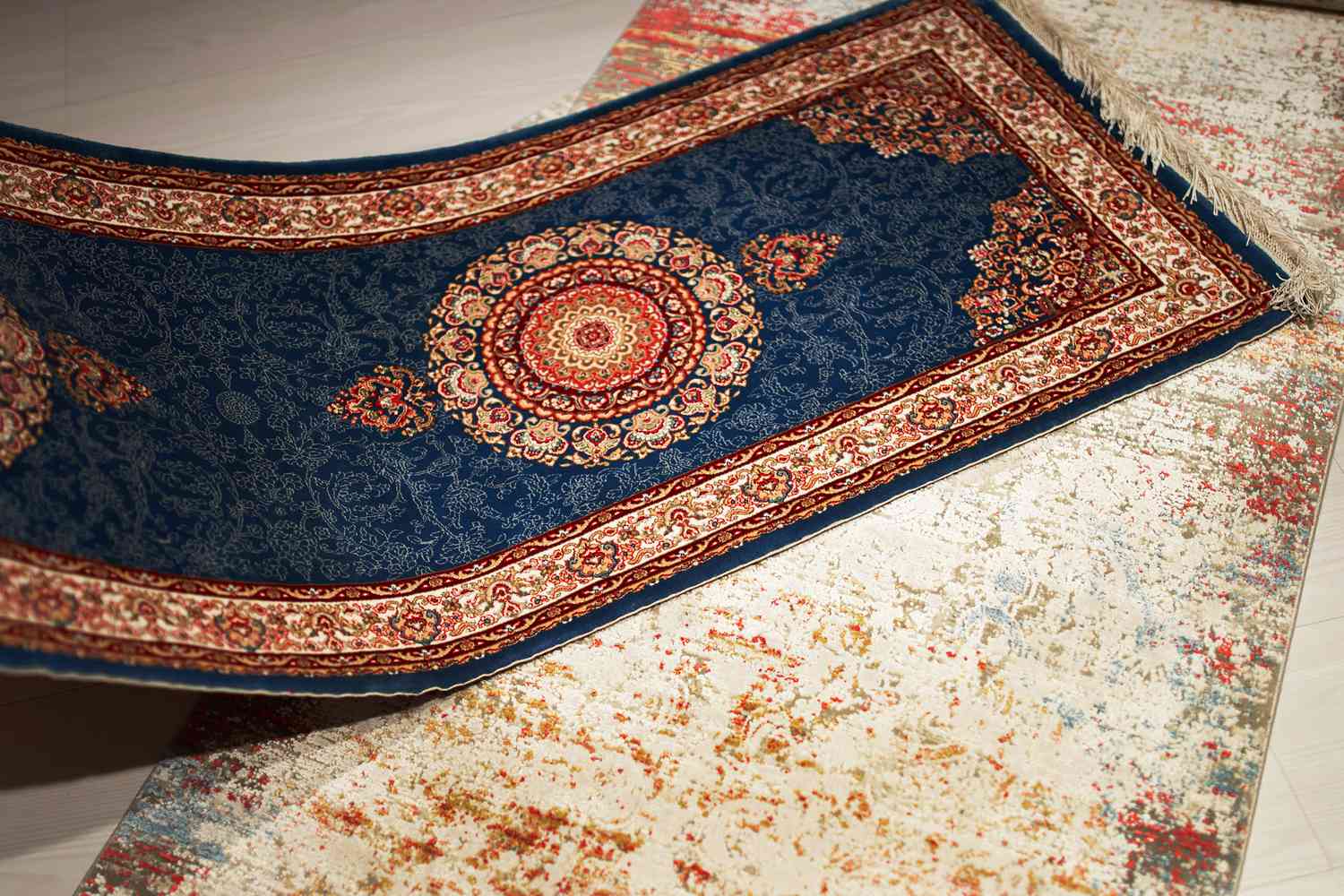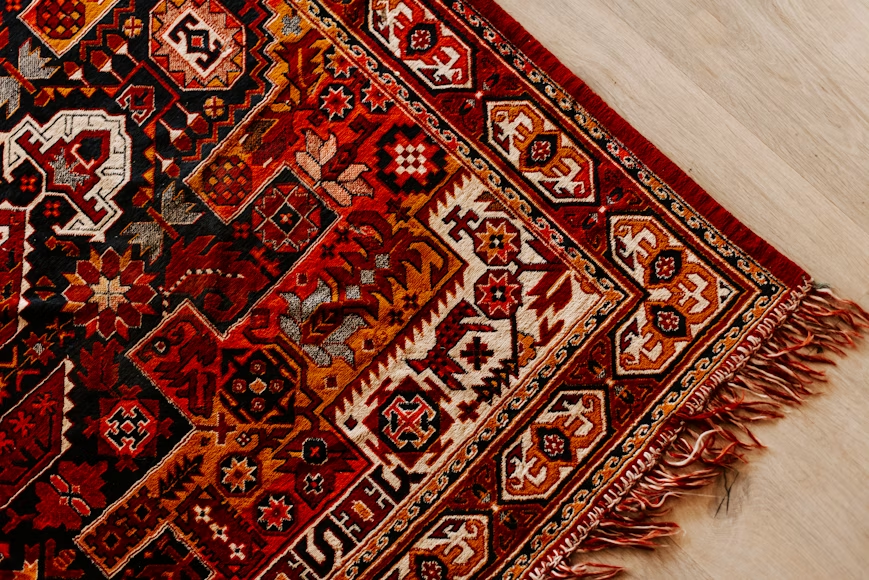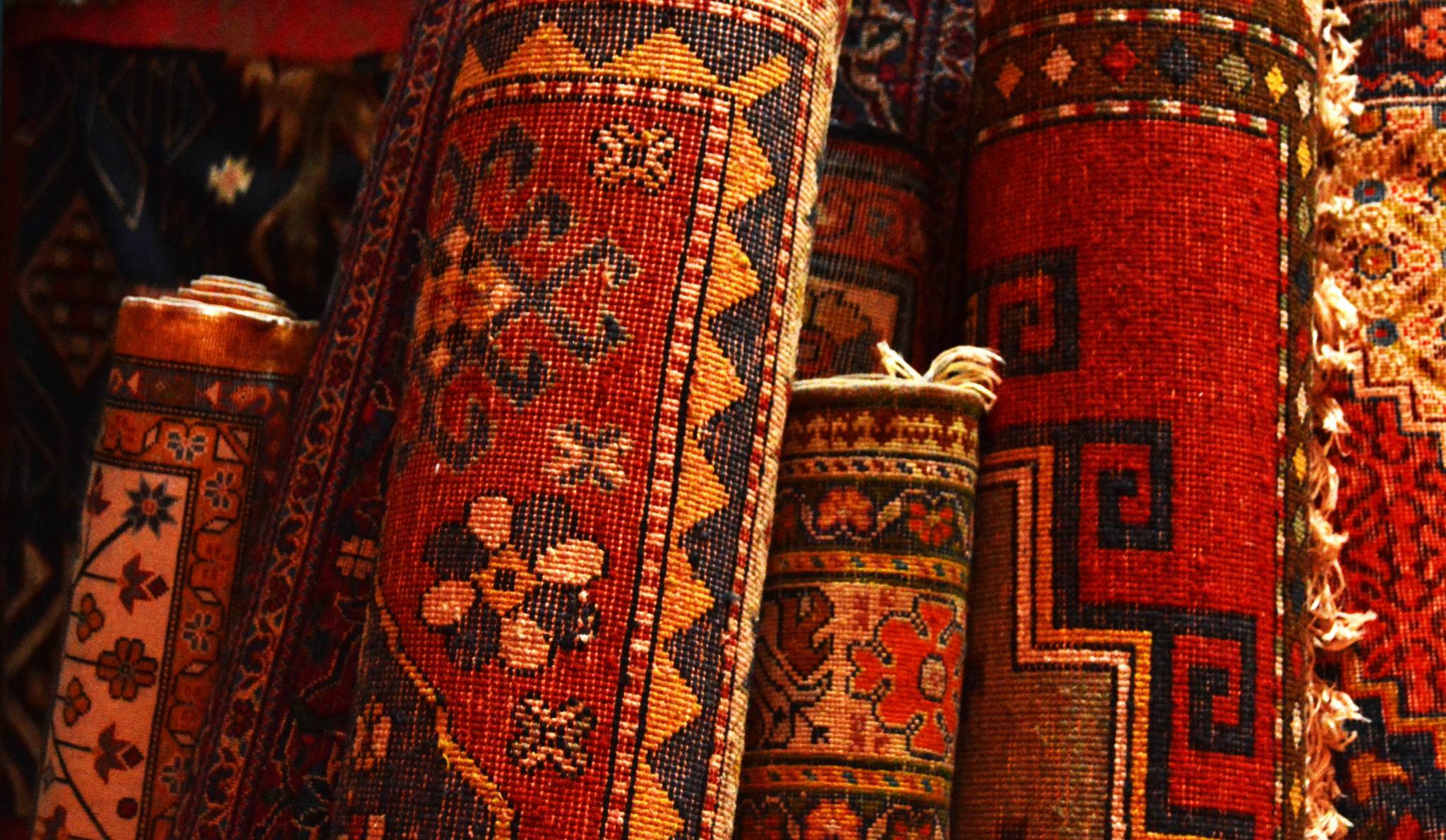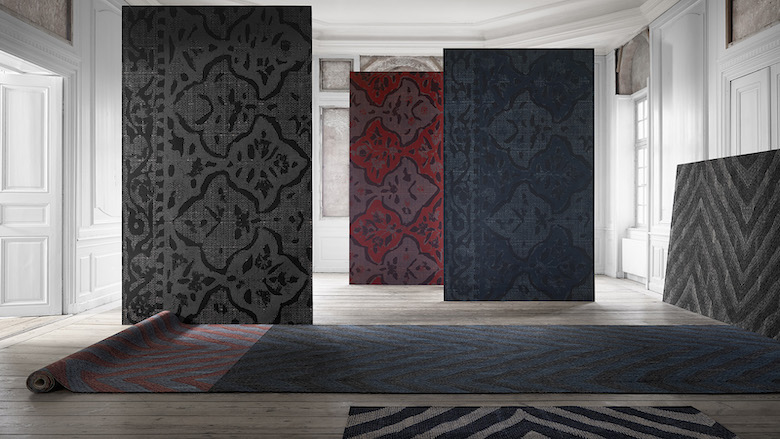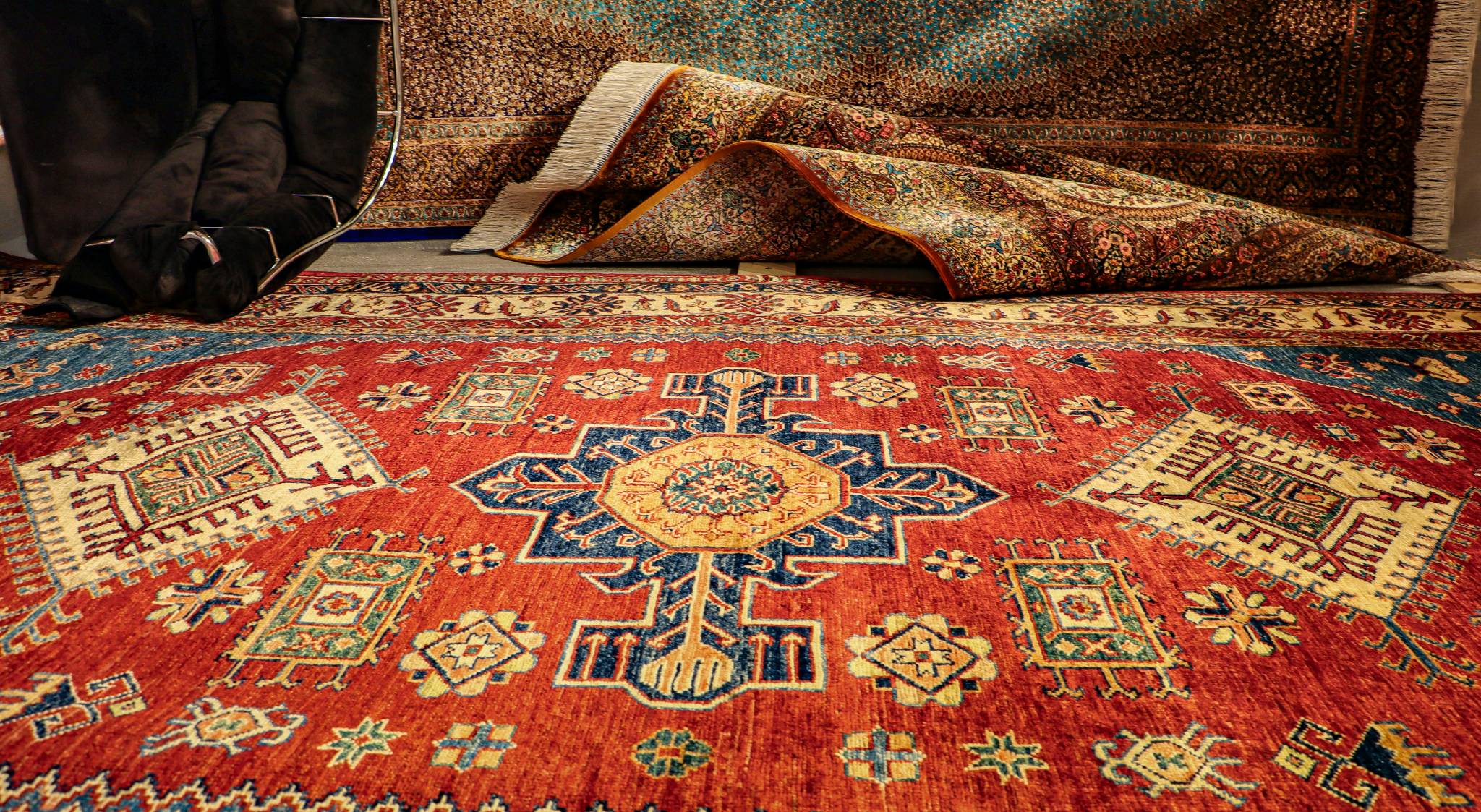Rug Glossary
Clear definitions of rug terminology and a guide to the parts of an Oriental rug.
The Parts of an Oriental Rug
Warps
Warps are the parallel strings stretched from loom beam to loom beam upon which rows of knots are tied. Most weavers use cotton for warp material if it is available because it is easier to weave a flat, straight rug on cotton warps than on wool warps (wool yarn is more elastic than cotton string, and is more affected by changes in humidity). Weavers who are semi-nomadic pastoralists (i.e., not farmers) are much more likely to use wool than cotton for warp and weft.
Wefts
Wefts run across the width of the rug, over and under the warp strings and between rows of knots. Most often, wefts are made of cotton, wool, or silk. Wefts help hold rows of knots in place and reinforce the rug's structure.
Knots
Knots are tied by looping yarn around pairs of warps and cutting off the standing end. The ends of the "knot" become the pile or nap of the rug.
Edge bindings
Edge bindings are made by wrapping several warps at the edge of the rug with yarn to reinforce this part of the rug.
Ends finish
Ends finish hold knots and wefts from working off the rug's warp strings. Many rug types have a flat-woven kilim selvedge at both ends.
Fringes
Fringes are formed by gathering and knotting together bundles of warp strings at both ends of the rug after the rug has been cut from the loom. The knots in these bundles of warp strings keep pile knots and end finishes tight at the rug's ends.
Rug Terms & Glossary
Abrash
The word used to describe the color variations found within a single color in an Oriental rug. It refers to the hue or color change found on many older rugs, particularly those woven by nomadic tribes. While abrash is commonly seen in tribal nomadic rugs, and in some modern Oriental rugs is intentionally woven with the color variation. The color variations are usually the result of inconsistent dyeing of the wool or the introduction of a new wool batch while weaving the carpet. Generally, some abrash is desirable in tribal carpets and very undesirable in "city" carpets.
Afshar
A Turkic-speaking nomadic and settled people living mostly in southern Iran. The Afshar make mostly small rugs and saddlebags, animal trappings. Tones of deep blue, red, gold, and ivory are most often encountered in Afshar rugs.
All-over design
A term used to describe the pattern of rugs whose fields have no central medallion. An even repeating design throughout the field.
Aniline dyes
Synthetic dyes were first invented (discovered) in 1856 by William Perkins. The term is now used to describe any synthetic dyes used in Oriental or Navajo rugs.
Antique Wash
A chemical or natural process that tones down colors to simulate aging.
Arabesque
An ornate curving design of intertwined floral and vine figures often seen in intricate workshop rugs such as those from Isfahan, Tabriz, Nain, and Qum.
Art Silk
Short for artificial silk, it is usually mercerized cotton, rayon, or polyester that appears to be silk. Oftentimes, artificial silk rugs are sold as real silk.
Asymmetrical Knot
"Persian" or "Senneh" knot. A pile knotting technique where only one or two warps are completely encircled.
Aubusson
Originally flat-weave rugs from 15th-century France; nowadays often made as a pile rug.
Axminster
Machine-made rug or carpet with individually inserted pile tufts; this allows complex color patterns and designs, including Oriental.
Backing
Fabric or yarns serving as a foundation for the face fiber.
Bakhtiari
The Bakhtiari confederation is a large and powerful group, covering much of central and southwestern Iran. Small rugs, saddlebags, and trappings are woven by nomadic Bakhtiaris, while large carpets are woven by the settled tribal people. The most familiar pattern is the garden design consisting of repeated squares or diamonds, each of which encloses a tree or floral motif. The name translates roughly as "the lucky ones".
Baluch
A large group of nomadic tribespeople living in Afghanistan and eastern Iran who weave many types of small rugs, animal trappings, and tent furnishings. They favor deep tones of blue, dark brown, dark red, and touches of natural ivory.
Berber
Naturally (undyed) looking rug or carpet; originally made by North African Berber tribes from undyed wool.
Bleeding
Dissolving of fiber dyes in a liquid.
Bokhara
The capital of Uzbekistan and the traditional trading center for Turkmen tribal carpets. Today, rugs called Bokhara are usually made in Pakistan using Tekke Turkmen designs.
Bonded
Or "fusion bonded" carpet, with tufts planted into a vinyl backing, has an impermeable backing with better tuft lock than any other construction type.
Boteh
This is a motif in stylized form representing either a pine cone, a palmetto, the sacred flame of Zoroaster, or a Cypress tree. Sometimes called a Paisley Pattern. Seen in many types of Oriental rugs.
Braided
Usually circular/oval rugs made of braided yarns.
Broadloom
Carpet wider than 6 feet.
Brocade
Flat-weave rug variation, in which additional colored weft strands are added over the existing warp and weft structure.
Carding
The task of pulling the wool fibers between two spiked paddles to arrange the fibers randomly. It is a first step before combing, which positions the fibers in a parallel arrangement.
Cartoon
This is a diagram of the rug design that weavers follow when knotting an oriental rug. Used in workshop rugs and some village rugs.
Cartouche
An oval-shaped ornamental design element usually containing an inscription or date.
Classical
A vague term referring to court carpets produced before the 19th century.
Cloudband
A stylized depiction of a cloud resembling a band knotted at its collar. Originally a Chinese design, but it is often seen in Persian Oriental rugs.
Combing
Drawing the already carded fibers through a set of spiked blocks to align the fibers in a parallel arrangement. This is done before spinning.
Cotton
A soft, natural plant fiber, inferior to wool and sisal, or hemp.
Curvilinear
With smooth curved patterns.
Cushion
Also "pad" or "underlay", a shock-absorbing material placed underneath a rug, or carpet.
Density
Individual fiber count per unit of rug/carpet area indicator; obtained from the pile yarn weight, or "face weight" (in ounces per sq. yard) divided by pile height (in inches).
Dyeing
Adding colors to rug/carpet fiber, yarn, or fabric; face fiber dyeing can be done before yarn is spun (solution or stock dyeing), after it (skein, package, or space dyeing), and after rug/carpet is put together (piece and continuous dyeing, printing).
Fading
Loss of color due to the effects of light, gases (ozone, nitric oxide, hydrogen sulfide), or chemicals (cleaners, bleach, chlorine).
Field
The main section of the rug that is surrounded by the border and contains the central medallion or other motifs.
Flatwoven
Rugs with the yarn woven through and along the warps.
Fringe
The excess warp threads extending from the end of the rug are sometimes finished in macramé-style knotting.
Frisé (free-zay)
Carpet with very tightly twisted pile, giving it a nubby/curled appearance.
Gauge
Separation between two neighboring tufting needles in inches; the smaller the gauge, the more dense the rug/carpet; quality units need to have 1/8 gauge or smaller.
Guard stripes
Bands which surround and enhance the main border. A thin stripe is used to highlight guards and to separate them from the beginning of the field.
Gul
This is an octagonal motif, usually elongated and divided into four. The word means "rose or flower".
Hali
A Turkish word for rug.
Halicilik
A Turkish word for rug merchant.
Handle
The weight and stiffness or flexibility of a rug. A rug´s handle might be described in terms such as flexible, stiff, or soft.
Herati design
This is a design feature often found in carpets from Persia. Usually, four leaves are woven around a well-defined diamond. This is sometimes referred to as the "Fish Design," but this design does not really represent fish.
Hooked
Made by pulling yarns through a backing.
Jute
Is a natural fiber often used for rug/carpet backing material.
Kilim
Originally small flat woven tribal or village rugs from east-central Asia.
Knitted
Machine-woven, woven, or hooked carpet.
Knot count
Number of knots per square inch.
Knotted
Usually a high-quality handmade woven rug made by tying each yarn tuft to the warp strand.
Lobe
A rounded division frequently found in medallions and border ornaments.
Loom
A frame or machine used for interlacing two or more sets of threads or yarns to form a rug or other textile.
Lozenge
A diamond-shaped parallelogram or rhombus.
Matting
Apparent rug/carpet pile crush caused by foot traffic.
Medallion
A large central ornament often featured on traditional oriental and European rugs.
Mihrab
Typical design of a prayer rug derived from the niche or chamber in a mosque.
Motifs
Single or repeated design elements found throughout the rug.
Nylon
Strong, resilient synthetic fiber; the two types used for most commercial carpets are 6 and 6.6; branded nylons have their properties specified by the manufacturer, unlike unbranded varieties.
Olefin (polypropylene)
A strong synthetic fiber with very good chemical properties and low resilience.
Pad
Also "cushion" or "underlay", a shock-absorbing material placed underneath a rug, or carpet.
Pile
Also, "face"; top surface of a carpet or rug.
Pile weave
A term used to refer to the structure of knotted carpets and rugs forming a pile or nap. Wool, silk, or sometimes cotton is knotted around the warp in a variety of techniques.
Pitch
Length between two neighboring stitches in woven rugs/carpets; expressed as several yarn ends in a 27-inch width.
Prayer rug
A small Oriental rug used by Muslims to kneel on when reciting their prayers. It should be noted, however, that most prayer rugs were woven for the foreign market.
Pushti
A small mat measuring about 2 x 3 feet.
Quatref
Round symmetrical ornaments with four lobes.
Raj
Number of knots per 7cm. (2 3/4 inches). Twenty-four psi would be approximately 76 knots per square inch.
Reciprocal design
A motif in contrasting colors, but a consistent repeating pattern. Borders often have reciprocal designs.
Resilience
The ability of the fiber to regain its original thickness after being subjected to compression force.
Rosette
A motif resembling an open flower consisting of a circular arrangement of parts around a center.
Runner
Long, narrow rug up to 3 feet wide.
Saf
A prayer rug containing multiple prayer niches.
Sarouk
Factory woven carpets woven in the vicinity of Sultanabad (Arak) in west central Iran. Named for a small town north of Sultanabad. Nearly all were exported to the United States.
Sculptured
With a pattern created by uneven pile height.
Shahsavan
A confederation of Turkic-speaking tribes living in Azerbaijan. They are known for making sumak bags and kilims.
Sisal
Strong, natural plant fiber used as rug face fiber.
Slit Tapestry technique
A technique commonly used on Kilims where the weft threads turn back at the meeting of different color areas. It is easily recognizable by the small gaps that appear where there are color changes.
Spandrel
An ornamental treatment located at the corners of the field.
Strapwork
An interlacing design resembling straps.
Soumak
A flat weave rug variety with a knot-free weaving technique.
Tapestry
Flat weave rug with intricate color/pattern details.
Tea Wash
A procedure used to soften the colors of a rug and give it the appearance of age.
Tekke
The largest Turkmen tribe in the 19th century, which made some of the finest Turkmen rugs.
Tuft bind
Force required to pull a tuft out of backing, with a minimum of 10 to 3 pounds of single pull force for loop and cut pile, respectively.
Tufted
Made on a machine with needles that insert pile yarn into a backing; the most economical serial rug/carpet production method.
Twist
Number of yarn twists per inch of pile yarn length; usually in the 3-5 range.
Underlay
Also "cushion" or "pad", shock-absorbing material placed underneath a rug, or carpet.
Velvet carpet
Woven on a velvet loom, typically in solid colors.
Warp
Length-wise running yarn in woven rug/carpets, interlacing with weft yarns.
Wool
A strong natural fiber of animal origin; the oldest, most luxurious after-silk rug face fiber material.
Watermark
Irreversible shading of large rug/carpet pile areas, due to different yarn fiber orientations; not a manufacturing defect.
Weft
Width-wise running yarn in woven rug/carpets, interlacing with warp yarns.
Woven
Rug or carpet created by interlacing wefts and warps into a unified backing/pile structure.
Yarn
A strand of fibers used for rug/carpet production.
Need More Answers?
Find quick clarifications on rug terms, care, and buying tips in our FAQ.
- If your issue isn’t resolved, contact support@usauctiononline.com.
- Review our Terms & Conditions for bidding and purchases.
- See our Privacy Policy to learn how we handle your data.

